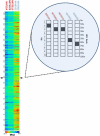Cyanophage tRNAs may have a role in cross-infectivity of oceanic Prochlorococcus and Synechococcus hosts
- PMID: 22011720
- PMCID: PMC3280135
- DOI: 10.1038/ismej.2011.146
Cyanophage tRNAs may have a role in cross-infectivity of oceanic Prochlorococcus and Synechococcus hosts
Abstract
Marine cyanobacteria of the genera Prochlorococcus and Synechococcus are the most abundant photosynthetic prokaryotes in oceanic environments, and are key contributors to global CO(2) fixation, chlorophyll biomass and primary production. Cyanophages, viruses infecting cyanobacteria, are a major force in the ecology of their hosts. These phages contribute greatly to cyanobacterial mortality, therefore acting as a powerful selective force upon their hosts. Phage reproduction is based on utilization of the host transcription and translation mechanisms; therefore, differences in the G+C genomic content between cyanophages and their hosts could be a limiting factor for the translation of cyanophage genes. On the basis of comprehensive genomic analyses conducted in this study, we suggest that cyanophages of the Myoviridae family, which can infect both Prochlorococcus and Synechococcus, overcome this limitation by carrying additional sets of tRNAs in their genomes accommodating AT-rich codons. Whereas the tRNA genes are less needed when infecting their Prochlorococcus hosts, which possess a similar G+C content to the cyanophage, the additional tRNAs may increase the overall translational efficiency of their genes when infecting a Synechococcus host (with high G+C content), therefore potentially enabling the infection of multiple hosts.
Figures







Similar articles
-
Genomic analysis of oceanic cyanobacterial myoviruses compared with T4-like myoviruses from diverse hosts and environments.Environ Microbiol. 2010 Nov;12(11):3035-56. doi: 10.1111/j.1462-2920.2010.02280.x. Environ Microbiol. 2010. PMID: 20662890 Free PMC article.
-
Prevalence and evolution of core photosystem II genes in marine cyanobacterial viruses and their hosts.PLoS Biol. 2006 Jul;4(8):e234. doi: 10.1371/journal.pbio.0040234. PLoS Biol. 2006. PMID: 16802857 Free PMC article.
-
Host-dependent differences in abundance, composition and host range of cyanophages from the Red Sea.Environ Microbiol. 2015 Apr;17(4):1286-99. doi: 10.1111/1462-2920.12569. Epub 2014 Aug 15. Environ Microbiol. 2015. PMID: 25041521
-
Cyanophage infection and photoinhibition in marine cyanobacteria.Res Microbiol. 2004 Nov;155(9):720-5. doi: 10.1016/j.resmic.2004.06.002. Res Microbiol. 2004. PMID: 15501648 Review.
-
T4 genes in the marine ecosystem: studies of the T4-like cyanophages and their role in marine ecology.Virol J. 2010 Oct 28;7:291. doi: 10.1186/1743-422X-7-291. Virol J. 2010. PMID: 21029435 Free PMC article. Review.
Cited by
-
Genome Analysis of Two Novel Synechococcus Phages That Lack Common Auxiliary Metabolic Genes: Possible Reasons and Ecological Insights by Comparative Analysis of Cyanomyoviruses.Viruses. 2020 Jul 25;12(8):800. doi: 10.3390/v12080800. Viruses. 2020. PMID: 32722486 Free PMC article.
-
Distinctive characters of Nostoc genomes in cyanolichens.BMC Genomics. 2018 Jun 5;19(1):434. doi: 10.1186/s12864-018-4743-5. BMC Genomics. 2018. PMID: 29866043 Free PMC article.
-
Cyanophage-encoded lipid desaturases: oceanic distribution, diversity and function.ISME J. 2018 Feb;12(2):343-355. doi: 10.1038/ismej.2017.159. Epub 2017 Oct 13. ISME J. 2018. PMID: 29028002 Free PMC article.
-
Transcriptome dynamics of a broad host-range cyanophage and its hosts.ISME J. 2016 Jun;10(6):1437-55. doi: 10.1038/ismej.2015.210. Epub 2015 Dec 1. ISME J. 2016. PMID: 26623542 Free PMC article.
-
A Novel Phage Infecting the Marine Photoheterotrophic Bacterium Citromicrobium bathyomarinum.Viruses. 2022 Mar 2;14(3):512. doi: 10.3390/v14030512. Viruses. 2022. PMID: 35336919 Free PMC article.
References
-
- Calladine CR, Drew HR. A useful role for ‘static' models in elucidating the behaviour of DNA in solution. J Mol Biol. 1996;257:479–485. - PubMed

